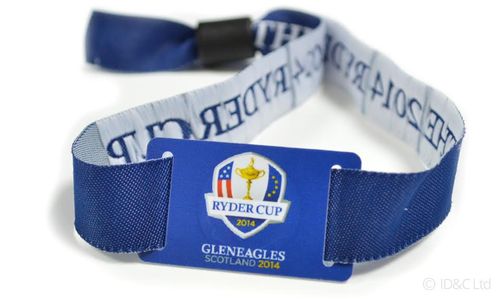It is not so simple to enhance in-golf course experience and compete with TVs that can show much more to a viewer. This is why contextual technologies are gaining momentum. Do you remember when in September 2013 NFL enabled (with Zebra Technologies) visitors to see the game on their tablets and iPhones inside the stadium (instead of watching it at home)?
Something similar happened in Ryder Cup 2014, in Gleneagles, Scotland, in a more sophisticated way.
At first time in Ryder Cup history, the organizers implemented Radio Frequency Identification (RFID). Fans attended Gleneagles, Scotland received Radio Frequency Identification (RFID) wristbands (see picture below) to go along with their tickets for entry. This is not a new technology, ski fans already enjoy the benefits of it for instance in Aspen Snowmass.
These wearables aimed to serve as the prism in which users can partake in the strategically deployed activities across the golf course, encouraging to share their experiences to social media at the very moment. This is a good way to reach those otherwise would not watch golf or follow up the Ryder Cup event so close. In brief to expand audience, engagement and fan demographic.
In this instance, the organizers used Intellitix. Each of their chips possesses a unique ID that can personalize the wristband through a user’s e-mail or social mediums. Together with the organizers Intellitix installed into walls, frames, and signage, with branding and a clear call-to-action to “tap here”. Fans could touch these markers with their wearable in order to proceed as part of the gamification.
Visitors were able to use this in such places as BMW Car Display, Ryder Cup Experience with Standard Life Investments. Just like the teams, visitors were able to compete against each other as well. They were also motivated to move around the golf course to win prizes (e.g. form Johnnie Walker). Of course they were able to support their team (it automtically published it also on Facebook and Twitter account of the fan) as well by simply pressing on the device.
At this moment I have no information if Ryder Cup was able to generate more revenue from the usage of wristbands for purchase.
However I am surprised why the organizers did not use NFC solution (Near Field Communication) or mobile wallet solutions (e.g. Google Wallet, Apple's Passbook, Lemon Wallet). Wouldn't be easier and seamless to use our mobile? I would be happy to know why did they choose RFID over other possible solutions?
When we select technology to achieve our goals and objectives, we should also consider potential risks and how many of our customers are using them as well.
Here are some of the risks of Radio Frequency Identification (RFID):
- RFID systems can be easily disrupted,
- RFID reader collision,
- RFID tags can be read without your knowledge,
- RFID tags with unque serial numbers could be linked to an individual credit card number….
While we are talking about NFC and mobile wallet, it is worth to think about wearables. In 2013, Credit Suisse that the market will explode to 50 billion USD within 5 years.
Thanks to Google, in June, I had the chance to test Google Glass. I think it can be also a golf championship event enhancer, as we do not have to use our mobile, but talk to our Google Glass who will give us information immediately.

